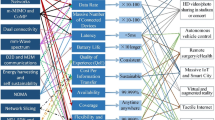Abstract
Ultra wideband (UWB) network brings both chance and challenge to personal area wireless communications. Compared with other IEEE 802 small range wireless protocols (such as WLAN and Bluetooth), UWB has both extremely high bandwidth (up to 480 Mbps) and low radiation. Moreover, the structured MAC layer of UWB is the fundamental difference to WLAN. The top one is that only when two UWB devices belong to the same piconet can they communicate with each other directly, which means that we must jointly consider topology formation and routing when deploying UWB networks because the interaction between routing and topology formation makes separate optimization ineffective. This paper tries to optimize UWB network from a cross-layer point of view. Specifically, given device spatial distribution and traffic requirement, we want to form piconets and determine routing jointly, to maximize the overall throughput. We formulate the problem of joint optimization to mixed-integer programming and give a practical lower bound that is very close to the theoretical upper bound in our simulation. Furthermore, our lower bound is much better than an algorithm that only considers topology formation in UWB networks.
Similar content being viewed by others
References
Boros E, Hammer P L. Pseudo-Boolean optimization. Discrete Appl Math, 2002, 123(1–3): 155–225
Basagni S, Bruno R, Mambrini G, et al. Comparative performance evaluation of scatternet formation protocols for networks of Bluetooth devices. ACM Wirel Networks, 2004, 10: 197–213
Gong M X, Midkiff S F, Buehrer R M. A new piconet formation algorithm for UWB ad hoc networks. In: IEEE Conference on Ultra Wideband Systems and Technologies, Reston, VA, Nov. 2003, 180–184
Gupta P, Kumar P R. The capacity of wireless networks. IEEE Trans Inform Theory, 2000, 46(2): 388–404
Li J, Blake C, Douglas S J, et al. Capacity of Ad Hoc Wireless Networks. In: ACM Mobicom’01, Rome, Italy, 2001, 61–69
Jain K, Padhye J, Padmanabhan V N, et al. Impact of interference on multi-hop wireless network performance. In: ACM Mobicom’03, San Diego, CA, USA, Sep. 2003, 66–80
Kodialam M, Nandagopal T. Characterizing achievable rates in multi-hop wireless networks: The joint routing and scheduling problem. In: ACM Mobicom’03, San Diego, CA, USA, Sep. 2003, 42–54
Zussman G, Segall A. Capacity assignment in bluetooth scatternets — Optimal and heuristic algorithms. Mobile Networks Appl, 2004, 9: 49–61
Raniwala A, Gopalan K, Chiueh T. Centralized channel assignment and routing algorithms for multi-channel wireless mesh networks. ACM SIGMOBILE Mobile Comput Commun Review (MC2R), 2004, 8(2): 50–65
Radunovic B, Le Boudec J-Y. Optimal power control, scheduling, and routing in UWB networks. IEEE J Selected Areas Commun, 2004, 22(7): 1252–1270
Feige U, Kilian J. Zero knowledge and the chromatic number. J Comput Syst Sci, 1998, 57(2): 187–199
Mehrotra A, Trick M A. A column generation approach for graph coloring, INFORMS. J Comput, 1996, 8(4): 344–354
Author information
Authors and Affiliations
Corresponding author
Additional information
The work was done when the first author WU Qi was visiting the Wireless and Networking Group, Microsoft Research Asia, and when he was a Ph.D. candidate in Institute of Computing Technology, Chinese Academy of Sciences.
Rights and permissions
About this article
Cite this article
Wu, Q., Bi, J., Guo, Z. et al. Cross-layer optimization in ultra wideband networks. SCI CHINA SER F 50, 760–770 (2007). https://doi.org/10.1007/s11432-007-0056-z
Received:
Accepted:
Issue Date:
DOI: https://doi.org/10.1007/s11432-007-0056-z





